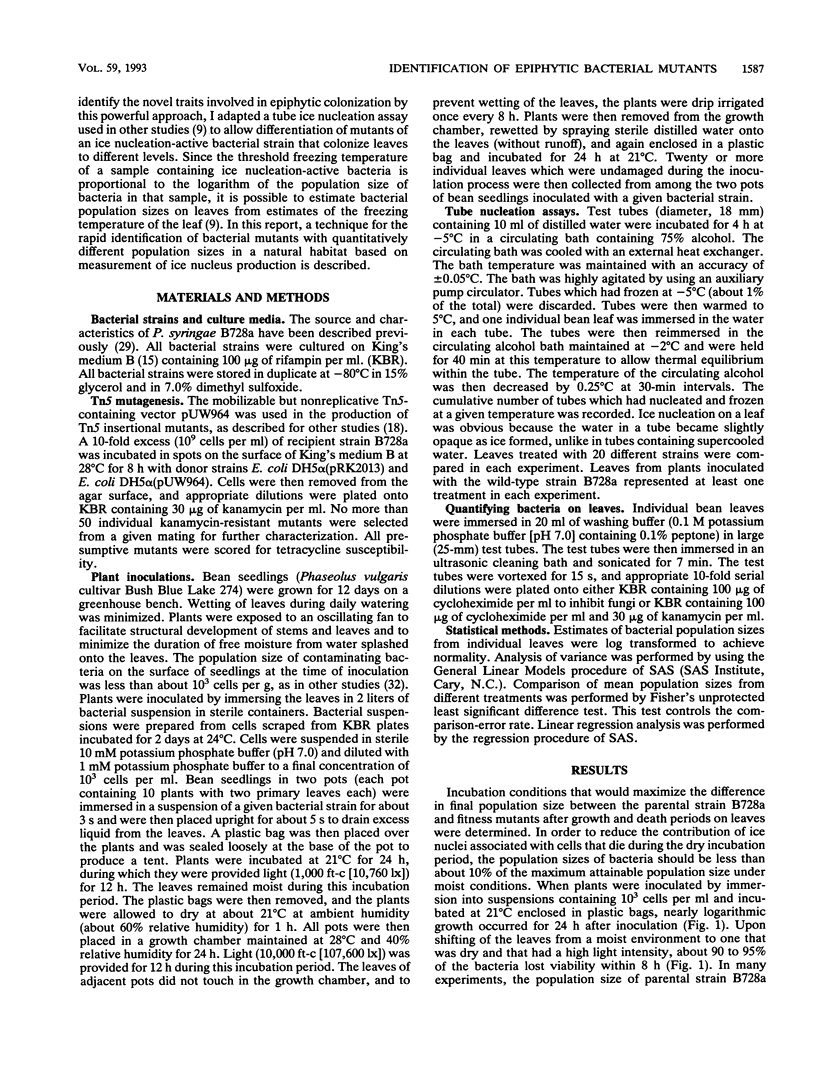Abstract
In order to identify novel traits involved in epiphytic colonization, a technique for the rapid identification of bacterial mutants with quantitatively different population sizes in a natural habitat based on measurements of ice nucleation activity was developed. The threshold freezing temperatures of leaves harboring different numbers of cells of ice nucleation-active Pseudomonas syringae B728a differed substantially. While few leaves containing less than about 106 cells per g (fresh weight) froze at assay temperatures of -2.75°C or higher, nearly all leaves froze at these temperatures when population sizes of this strain increased to about 107 cells per g (fresh weight). Presumptive epiphytic fitness mutants could readily be identified as strains which initiated freezing in fewer leaves than did other strains within a given experiment. Most Tn5-induced mutants of strain B728a which conferred a low frequency of ice nucleation on inoculated bean leaves generally had a smaller population size than the parental strain at the time of the leaf freezing assay. The leaf freezing assay was capable of differentiating samples which varied by approximately three- to fivefold in mean bacterial population size.
Full text
PDF






Selected References
These references are in PubMed. This may not be the complete list of references from this article.
- Anderson J. A., Ashworth E. N. The Effects of Streptomycin, Desiccation, and UV Radiation on Ice Nucleation by Pseudomonas viridiflava. Plant Physiol. 1986 Apr;80(4):956–960. doi: 10.1104/pp.80.4.956. [DOI] [PMC free article] [PubMed] [Google Scholar]
- Govindarajan A. G., Lindow S. E. Phospholipid requirement for expression of ice nuclei in Pseudomonas syringae and in vitro. J Biol Chem. 1988 Jul 5;263(19):9333–9338. [PubMed] [Google Scholar]
- Govindarajan A. G., Lindow S. E. Size of bacterial ice-nucleation sites measured in situ by radiation inactivation analysis. Proc Natl Acad Sci U S A. 1988 Mar;85(5):1334–1338. doi: 10.1073/pnas.85.5.1334. [DOI] [PMC free article] [PubMed] [Google Scholar]
- Haefele D. M., Lindow S. E. Flagellar Motility Confers Epiphytic Fitness Advantages upon Pseudomonas syringae. Appl Environ Microbiol. 1987 Oct;53(10):2528–2533. doi: 10.1128/aem.53.10.2528-2533.1987. [DOI] [PMC free article] [PubMed] [Google Scholar]
- Hirano S. S., Baker L. S., Upper C. D. Ice nucleation temperature of individual leaves in relation to population sizes of ice nucleation active bacteria and frost injury. Plant Physiol. 1985 Feb;77(2):259–265. doi: 10.1104/pp.77.2.259. [DOI] [PMC free article] [PubMed] [Google Scholar]
- Hirano S. S., Nordheim E. V., Arny D. C., Upper C. D. Lognormal distribution of epiphytic bacterial populations on leaf surfaces. Appl Environ Microbiol. 1982 Sep;44(3):695–700. doi: 10.1128/aem.44.3.695-700.1982. [DOI] [PMC free article] [PubMed] [Google Scholar]
- Hirano S. S., Upper C. D. Diel Variation in Population Size and Ice Nucleation Activity of Pseudomonas syringae on Snap Bean Leaflets. Appl Environ Microbiol. 1989 Mar;55(3):623–630. doi: 10.1128/aem.55.3.623-630.1989. [DOI] [PMC free article] [PubMed] [Google Scholar]
- KING E. O., WARD M. K., RANEY D. E. Two simple media for the demonstration of pyocyanin and fluorescin. J Lab Clin Med. 1954 Aug;44(2):301–307. [PubMed] [Google Scholar]
- Lindgren P. B., Frederick R., Govindarajan A. G., Panopoulos N. J., Staskawicz B. J., Lindow S. E. An ice nucleation reporter gene system: identification of inducible pathogenicity genes in Pseudomonas syringae pv. phaseolicola. EMBO J. 1989 May;8(5):1291–1301. doi: 10.1002/j.1460-2075.1989.tb03508.x. [DOI] [PMC free article] [PubMed] [Google Scholar]
- Lindgren P. B., Peet R. C., Panopoulos N. J. Gene cluster of Pseudomonas syringae pv. "phaseolicola" controls pathogenicity of bean plants and hypersensitivity of nonhost plants. J Bacteriol. 1986 Nov;168(2):512–522. doi: 10.1128/jb.168.2.512-522.1986. [DOI] [PMC free article] [PubMed] [Google Scholar]
- Lindow S. E., Andersen G., Beattie G. A. Characteristics of Insertional Mutants of Pseudomonas syringae with Reduced Epiphytic Fitness. Appl Environ Microbiol. 1993 May;59(5):1593–1601. doi: 10.1128/aem.59.5.1593-1601.1993. [DOI] [PMC free article] [PubMed] [Google Scholar]
- Lindow S. E., Arny D. C., Upper C. D. Bacterial ice nucleation: a factor in frost injury to plants. Plant Physiol. 1982 Oct;70(4):1084–1089. doi: 10.1104/pp.70.4.1084. [DOI] [PMC free article] [PubMed] [Google Scholar]
- Lindow S. E., Hirano S. S., Barchet W. R., Arny D. C., Upper C. D. Relationship between Ice Nucleation Frequency of Bacteria and Frost Injury. Plant Physiol. 1982 Oct;70(4):1090–1093. doi: 10.1104/pp.70.4.1090. [DOI] [PMC free article] [PubMed] [Google Scholar]
- Lindow S. E., Lahue E., Govindarajan A. G., Panopoulos N. J., Gies D. Localization of ice nucleation activity and the iceC gene product in Pseudomonas syringae and Escherichia coli. Mol Plant Microbe Interact. 1989 Sep-Oct;2(5):262–272. doi: 10.1094/mpmi-2-262. [DOI] [PubMed] [Google Scholar]
- Maki L. R., Galyan E. L., Chang-Chien M. M., Caldwell D. R. Ice nucleation induced by pseudomonas syringae. Appl Microbiol. 1974 Sep;28(3):456–459. doi: 10.1128/am.28.3.456-459.1974. [DOI] [PMC free article] [PubMed] [Google Scholar]
- Warren G., Wolber P. Molecular aspects of microbial ice nucleation. Mol Microbiol. 1991 Feb;5(2):239–243. doi: 10.1111/j.1365-2958.1991.tb02104.x. [DOI] [PubMed] [Google Scholar]


